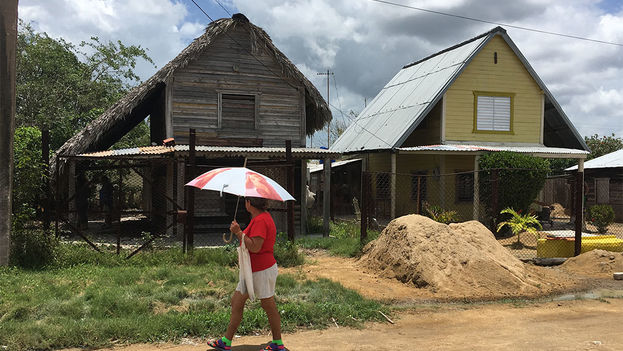
![]() 14ymedio, Reinaldo Escobar, Florida, Cuba, 26 June 2017 — “The sea water cleans everything,” Agustin reflects as he calls out his merchandise. This 74-year-old forensic assistant now works renting inflatable boats for the fishermen of Playa Florida, in Camagüey, a coastal strip where tourists rarely come and the economic crisis is strongly felt.
14ymedio, Reinaldo Escobar, Florida, Cuba, 26 June 2017 — “The sea water cleans everything,” Agustin reflects as he calls out his merchandise. This 74-year-old forensic assistant now works renting inflatable boats for the fishermen of Playa Florida, in Camagüey, a coastal strip where tourists rarely come and the economic crisis is strongly felt.
“I came here to escape the odor of death, and I did,” jokes the worker, one of the few residents in the unpopulated streets on Friday. On every side many of the few houses that do not seem vacant exhibit a “for sale” sign. “All of Playa Florida is for sale but no one wants to buy it,” a resident jokes.
Lacking the natural beauty of the north coast, with no functioning industries and no important crops, the area is experiencing times of hardship that have worsened in recent years. On the entrance road, a rusted out anchor gives visitors a preview of the lethargy they will find here.
Only 24 miles separate the fishermen’s village from the municipal center, but it takes between four and six hours to cover the route due to the poor state of the road and the lack of public transport. On both sides of the road, the invasive marabou weed rises defiantly.
“Without tourists there is no money,” says Bururu, an informal realtor.
Lack communication characterizes the village. Nowhere among its crowded streets has a public telephone been installed and cell phones only manage to pick up a signal near the medical clinic, due to the poor coverage of the area.
The lack of mobility also sinks the area’s small businesses. The private restaurant Comida Criollo barely survives after being opened five years. Alfredo, the paladar’s chef, says that “from time to time a foreign tourist arrives.” People who “explore every corner with a map in hand,” but they are fewer and fewer.
Of the 4 million visitors who arrived in Cuba last year, only a few dozen came to this coast without white sands or crystal clear water, where to take a dip the bather must wear shoes to avoid the mud, stones and mangrove roots.
“Without tourists there is no money,” Bururu, an informal realtor, tells 14ymedio. The high number of homes for sale has caused a collapse of prices in the area. “A two-room house with a covered porch, cistern and garden can cost less than 1,000 CUC (roughly $1,000 US),” he says.
“People do not want to stay because there is nothing to do here”
“They put a jacuzzi in the bathroom and all the furniture inside is from the mall,” says Bururú while pointing to a newly painted building. The dealer takes his time to describe the characteristics of each house, hoping to make at least one sale.
“People do not want to stay because there is nothing to do here,” he explains to the 14ymedio. The man blames the stampede on the fact that “there are no recreational options and also nowhere to work”. “[The fishing] is not as good as in other places, so it gives you something to eat but not enough to make a living,” he emphasizes.
Near the coastline, a fisherman removes the scales from a sea bass he caught that morning. “I promised it to a family that wants to celebrate the birthday of their youngest son,” he tells a woman who inquires about the price of fish.
“The fishing is very affected since they built the embankment,” says the fisherman. “This area used to get a lot of oysters, but that has decreased a lot,” he adds.
The coast has also been affected by rising sea levels, to the extent that rumors of relocating the village have increased in recent years
The narrow and rugged access road divides the wetland in two and it has lost a part of the mangroves in its southern area. “Experts came here to research it and said that cutting the flow of water had increased the salinity and that is killing the mangroves.”
In 2009 the United Nations Small Grants Program provided more than $40,000 in funding for ecosystem recovery, but eight years later the damage has hardly been reversed. “The sea water has entered the river Mala Fama inland,” says the fisherman.
The coast has also been affected by rising sea levels, to the extent that rumors of relocating the village have increased in recent years. Wooden palisades are trying to slow down the push of the waves during hurricanes, but they seem like ridiculous chopsticks in the face of the immensity of the Caribbean.
The picture of deterioration is completed by the Argentina Campsite. where for months there has been neither electricity nor water. Julia, the guard who watches the entrance of the abandoned place, is categorical. “Here in Florida Beach, the only thing that is abundant is gnats and mosquitoes.”
